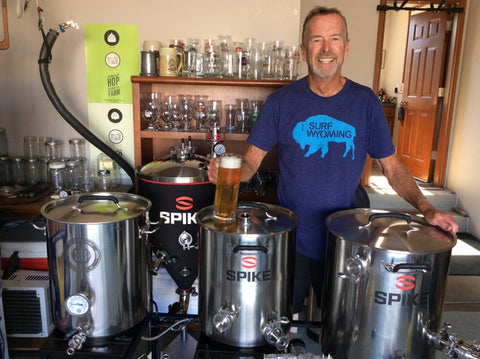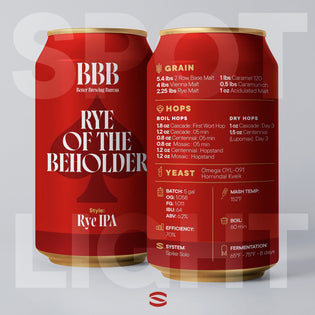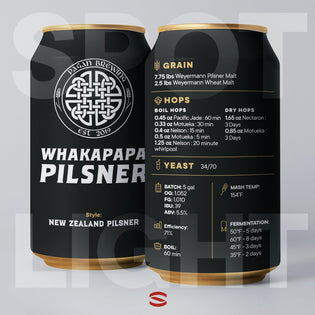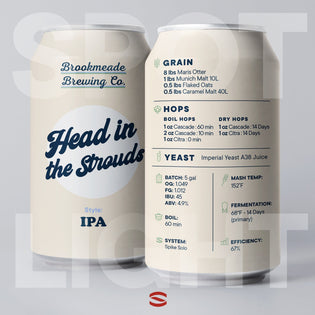
The Brewer: Duane Teachout
I have been brewing beer at home for over 15 years. Across all those years the quest has always been the same: make every batch the best batch yet! After being a BJCP judge for many years, and also entering (and winning) several competitions, I now try to help others through my YouTube channel, HomeBrewingTips. Feel free to check out the latest video on this very beer!

The Beer: Kölsch
To me, Kölsch is the Pilsner’s cousin. It is the perfect beer for a summer’s day. Its unique cool ale fermentation and quasi-lagering period provide a wonderful crispness to this beer that is very quenching. I’ve added a Pacific Northwest twist to this recipe through the use of Mt. Hood hops in place of traditional Hallertauer.

The Recipe: Cool Breeze Kölsch

INGREDIENTS
GRAIN
- 16 lbs Weyermann Pilsner
- 0.5 lbs CaraVienna
- 0.5 lbs Victory Malt
- 0.5 lbs CaraFoam
HOPS
- 1.5 oz Mount Hood FWH
- 1.5 oz Mount Hood Flame Out
- 1 oz Tettnang Flame Out
YEAST
- Imperial Dieter (G03)

INSTRUCTIONS
BATCH SIZE: 8 gal
OG: 1.051
FG: 1.011
IBU: 21
ABV: 5.4%
EFFICIENCY: 80%
MASH TEMP: 150ºF
BOIL: 60min
FERMENTATION:
63ºF then lager at 50ºF
SYSTEM: Custom 3-Vessel System
Pro Tips
- For a more traditional recipe, replace Mt. Hood hops with Hallertaurer at a 1:1 ratio.
- “Cool” ferment, and once passed VDK reduce temperature to 50 degrees and lager for two weeks.
- Add whirlflock (or other kettle finings) with 15 minutes left in the boil.
- To achieve striking clarity, use gelatin (or biofine) as your post fermentation clarifier.
Cheers,
Duane Teachout - West Wind Brewery
Spike Summarizes: All Things Kölsch Beer
What is a Kölsch?
Kölsch is a traditional beer style that originated in Cologne, Germany. It is a pale and clear beer known for its crisp and clean character, light to medium body, and refreshing taste. Kölsch is unique in that it is a hybrid beer, combining the characteristics of an ale and a lager.
What distinguishes Kölsch from other beers?
Kölsch stands out from other beer styles due to its distinct combination of brewing techniques and flavor profile.
Hybrid Brewing Method
Kölsch is brewed using a hybrid method that incorporates aspects of both ale and lager brewing. It is fermented with ale yeast but then undergoes a cold conditioning process similar to lagers. This hybrid approach results in a beer that exhibits qualities of both styles, creating a delicate and balanced flavor profile.
Crisp and Clean Character
One of the defining characteristics of Kölsch is its crisp and clean taste. It has a subtle malt sweetness and a mild hop bitterness, with a well-rounded and smooth finish. The clean fermentation profile contributes to its refreshing nature, making it highly drinkable.
Kölsch is typically pale in color, ranging from straw to light gold. It is known for its clarity, with minimal to no haze. The clarity of Kölsch is achieved through precise brewing techniques and cold conditioning.
What's the history of Kölsch beer?
Kölsch has a rich history that dates back several centuries to the city of Cologne (Köln) in western Germany.
Brewing Tradition of Cologne
The beer style originated in Cologne, where it has been brewed since the early 17th century. The city has a strong brewing tradition, and Kölsch has become an integral part of its cultural identity. Kölsch is protected as a regional specialty under the Kölsch Konvention, ensuring its authenticity and quality.
Historically, Cologne had a unique guild system that regulated the brewing industry. The guilds maintained strict standards for brewing Kölsch, preserving the beer's traditions and ensuring its consistent quality. Today, a few breweries in Cologne still adhere to these traditional brewing methods.
Kölsch is not just a beer style; it is deeply intertwined with the culture and lifestyle of Cologne. It is often enjoyed in local brewpubs called "Brauhauses" or in outdoor beer gardens known as "Biergartens." Kölsch is also an integral part of celebrations, festivals, and social gatherings in the region.
What does Kölsch taste like?
Kölsch offers a distinctive flavor profile that combines subtle malt sweetness with a clean and balanced character.
Malt Profile
Kölsch exhibits a light to medium malt profile, with a mild sweetness. The malt flavors are clean and smooth, often with notes of bread or biscuit. The malt character serves as a foundation for the beer's overall balance and drinkability.
Hop Bitterness
While Kölsch is not intensely bitter, it features a noticeable yet restrained hop bitterness. The hops contribute a subtle spicy or floral note, providing a gentle counterpoint to the malt sweetness. The bitterness is usually well-balanced, ensuring a harmonious flavor experience.
Delicate and Balanced
What sets Kölsch apart is its delicate and balanced nature. The malt and hop flavors meld together seamlessly, resulting in a harmonious and nuanced taste. The clean fermentation profile and cold conditioning contribute to the beer's overall smoothness and drinkability.
The combination of a clean malt backbone, subtle hop bitterness, and crisp finish makes Kölsch a highly refreshing and enjoyable beer style.
How is Kölsch beer made?
The brewing process for Kölsch involves several key steps to achieve its distinctive characteristics.
Single Infusion Mash
Kölsch begins with a single infusion mash, where a mixture of malted barley, often Pilsner malt, and a small portion of wheat malt is combined with hot water. This process activates enzymes that convert the starches in the grains into fermentable sugars.
Lautering and Sparging
After the mash, lautering takes place. Lautering involves separating the liquid wort from the spent grain by filtering it through the mash bed. Sparging follows, which involves rinsing the grain with hot water to extract any remaining sugars. This ensures maximum efficiency in sugar extraction and helps achieve the desired specific gravity of the beer.
Boiling and Hop Additions
The wort is then transferred to a brew kettle, where it is brought to a boil. During the boiling process, hops are added at specific intervals to provide bitterness and contribute to the overall flavor profile. Noble hop varieties such as Hallertau or Tettnang are commonly used in Kölsch to impart a mild, floral, and spicy aroma.
Fermentation with Ale Yeast
After boiling, the wort is rapidly cooled and transferred to a fermentation vessel. Kölsch is fermented with ale yeast strains at relatively cool temperatures, typically around 15-20°C (59-68°F). This fermentation process imparts the unique fruity esters and subtle flavors characteristic of Kölsch.
Cold Conditioning
Once primary fermentation is complete, Kölsch undergoes a cold conditioning phase, also known as lagering. During this period, the beer is stored at near-freezing temperatures for several weeks. This extended cold conditioning helps clarify the beer, enhances its crispness, and promotes the development of a clean and smooth flavor profile.
Carbonation and Packaging
After cold conditioning, the beer is carbonated either through natural carbonation or forced carbonation. Natural carbonation occurs when a small amount of fermentable sugar is added to the beer before bottling or kegging, allowing for secondary fermentation in the package. Kölsch is traditionally packaged in tall, slender 200ml (6.8 fl oz) glasses called "Stangen" or in 500ml (16.9 fl oz) bottles.
The combination of careful brewing techniques, fermentation with ale yeast, and cold conditioning contribute to the unique character of Kölsch beer.
What foods go best with Kölsch?
Kölsch's crisp and clean flavors make it a versatile beer when it comes to food pairings. It complements a wide range of dishes, enhancing flavors without overpowering them. Here are some food pairing suggestions to explore:
German Cuisine
Given Kölsch's origins, it pairs naturally with traditional German dishes. Sausages, such as bratwurst or currywurst, are classic companions to Kölsch. The beer's refreshing qualities cut through the richness of the sausages, providing a harmonious balance. Other German dishes like schnitzel, pretzels, and sauerkraut also pair well with Kölsch.
Seafood
The light and crisp nature of Kölsch makes it an excellent partner for seafood. Grilled or pan-seared fish, shrimp, or scallops work particularly well. The beer's subtle malt sweetness and mild hop bitterness complement the delicate flavors of the seafood without overpowering them.
Salads and Light Fare
Kölsch's refreshing qualities and clean character make it an ideal choice for pairing with salads and light appetizers. It goes well with green salads, goat cheese, fresh vegetables, and light vinaigrettes. The beer's effervescence and subtle hop notes provide a pleasant contrast to the crisp textures and flavors of these dishes.
Spicy Cuisine
Kölsch's gentle hop bitterness and clean finish make it a suitable partner for spicy foods. It can help temper the heat and refresh the palate. Consider pairing Kölsch with spicy Thai dishes, Mexican cuisine, or Indian curries. The beer's crispness and light body provide a cooling effect, balancing the spiciness of the food.
Cheese Pairings
Kölsch pairs well with a variety of cheeses. Mild and creamy cheeses like Gouda, Camembert, or Brie complement the beer's clean flavors. Additionally, tangy cheeses like goat cheese or feta can create a delightful contrast with Kölsch's subtle sweetness and crispness.
Is Kölsch a year-round beer?
Yes, Kölsch is a beer style that can be enjoyed year-round, offering versatility for various seasons and occasions.
Kölsch's light and crisp character makes it a popular choice during the summer months. Its refreshing qualities and lower alcohol content make it an excellent thirst-quencher on hot days. Whether you're enjoying a barbecue, picnic, or outdoor gathering, Kölsch can be a go-to beer for summer enjoyment.
Kölsch also transitions well into the milder seasons of spring and fall. As temperatures begin to warm up or cool down, Kölsch's clean and balanced flavors can provide a pleasant and refreshing drinking experience. It serves as a bridge between the lighter beers of summer and the heartier brews of winter.
While not as commonly associated with winter as some other beer styles, Kölsch can still be enjoyed during the colder months. Its clean and crisp qualities offer a welcome contrast to the heavier and maltier winter beers. Some breweries even produce seasonal variations of Kölsch, incorporating spices or flavors that evoke a cozy and festive winter atmosphere.
In summary, Kölsch is a versatile beer style suitable for year-round enjoyment, adapting to the preferences and occasions of different seasons.
How strong is a typical Kölsch?
A typical Kölsch beer has a moderate alcohol content, making it an approachable and sessionable beer.
Alcohol by Volume (ABV)
The alcohol by volume (ABV) of Kölsch typically ranges from 4.4% to 5.3%. This ABV range places it in the moderate-strength category. The moderate alcohol content allows for easy drinking and extended enjoyment without the effects of higher alcohol beers.
Are there different variations of Kölsch beers?
While Kölsch is a specific beer style associated with the city of Cologne, there is some variation within the category.
Traditional Kölsch
Traditional Kölsch adheres closely to the guidelines and brewing methods established by the Kölsch Konvention. Breweries in Cologne, Germany, that carry the Kölsch designation must follow strict regulations to ensure authenticity. Traditional Kölsch is characterized by its pale color, clean malt profile, subtle hop bitterness, and a crisp, refreshing finish.
Kölsch-style Beers
Outside of Cologne, many breweries create Kölsch-style beers that may deviate slightly from the traditional style. These variations can include the use of different hop varieties, experimental ingredients, or techniques. While they may not have the official Kölsch designation, they can still offer similar characteristics and enjoyable drinking experiences.
It's worth noting that to be considered a true Kölsch, a beer must come from Cologne and follow the specific brewing guidelines. Kölsch-style beers produced outside of Cologne may offer a similar flavor profile but should be recognized as interpretations rather than traditional Kölsch.
What's the correct temperature for serving Kölsch?
The recommended serving temperature for Kölsch is relatively cool, allowing its crisp and refreshing qualities to shine.
Chilled to Cool Temperature
Kölsch is typically served between 7°C and 10°C (45°F and 50°F). This temperature range ensures that the beer is cool but not overly cold. Serving Kölsch at a chilled temperature enhances its refreshing character and allows the flavors and aromas to be fully appreciated.
Glassware
Kölsch is traditionally served in a tall, slender glass called a "Stange." The Stange glass showcases the beer's pale color, clarity, and effervescence. Its narrow shape helps retain the beer's carbonation and accentuates the aromas, providing a more enjoyable sensory experience. However, if a Stange glass is not available, a standard pint glass or a narrow tulip-shaped glass can also work well for serving Kölsch.
By serving Kölsch at the recommended temperature in an appropriate glass, you can fully appreciate its crispness, delicate flavors, and overall refreshing qualities.
Where can I buy the best Kölsch beers?
Finding the best Kölsch beers largely depends on your location and the availability of craft beer establishments or specialty beer shops. Here are a few options to explore when seeking out quality Kölsch beers:
Local Breweries and Taprooms
Start by checking out local breweries in your area. Many craft breweries experiment with various beer styles, including Kölsch. Visiting their taprooms allows you to sample Kölsch beers directly from the source and potentially discover unique and limited-edition variations. Some breweries may even offer Kölsch in cans or bottles for purchase.
Beer Stores and Bottle Shops
Specialty beer stores and bottle shops often carry a wide selection of craft beers, including Kölsch. These establishments have knowledgeable staff who can guide you to the best Kölsch options available. They may stock beers from local, regional, or international breweries, providing you with a range of choices.
Online Retailers
In the age of e-commerce, online retailers have made it easier to access a broader selection of beers, including Kölsch. Many online platforms specialize in craft beer and offer delivery services. Check if there are reputable online retailers in your region that can ship Kölsch beers to your doorstep.
Is Kölsch a good beer style for beginners?
Yes, Kölsch is often regarded as a good beer style for beginners due to its approachable nature and balanced flavors.
Mild Bitterness
Kölsch typically has a mild hop bitterness, which can be more appealing to individuals who are not accustomed to strong or intense bitterness. The gentle hop profile allows the malt sweetness and crispness to shine through, creating a well-rounded and pleasant drinking experience.
Clean and Crisp Taste
The clean and crisp taste of Kölsch makes it highly drinkable and refreshing. It doesn't overwhelm the palate with complex or overpowering flavors, making it easier for beginners to appreciate and enjoy. The beer's smooth finish and balanced profile make it a great introduction to craft beer.
Versatility
Kölsch's versatility is another reason why it's suitable for beginners. It pairs well with a wide range of foods and can be enjoyed in various settings, from casual social gatherings to more formal occasions. Its wide availability also makes it accessible for those looking to explore different beer styles.
Gateway to Other Styles
Kölsch can serve as a gateway beer, introducing beginners to the world of craft beer. Its moderate alcohol content and appealing flavor profile provide a solid foundation for individuals to explore and appreciate other beer styles with more complexity and diversity.
While personal preferences may vary, Kölsch's balanced flavors, mild bitterness, and refreshing qualities make it an excellent choice for beginners who are just starting to discover and explore the world of beer.
How does Kölsch differ from other beer styles like Pilsner or Lager?
Kölsch has distinct characteristics that differentiate it from other beer styles such as Pilsner or Lager.
Ale Brewing Method
Unlike Pilsners and Lagers, which are typically fermented with bottom-fermenting yeast (Saccharomyces pastorianus), Kölsch is brewed with ale yeast (Saccharomyces cerevisiae). This results in a different fermentation profile, with Kölsch often exhibiting fruity esters and a cleaner, less sulfury character compared to Lagers.
Hybrid Beer Style
While Pilsners and Lagers are known for their bottom-fermenting yeast and longer cold conditioning periods, Kölsch combines elements of both ale and lager brewing methods. It is fermented with ale yeast at warmer temperatures but then undergoes cold conditioning, similar to lagers. This hybrid approach gives Kölsch its unique characteristics and a balanced flavor profile.
Crisp and Refreshing Profile
Kölsch is known for its crisp and refreshing taste, with a delicate balance of malt sweetness and hop bitterness. It tends to have a lighter body and a slightly fruity character from the ale yeast, which sets it apart from the more malt-focused Pilsners and the drier and cleaner Lagers.
Regional Identity
Kölsch is closely associated with the city of Cologne (Köln) in Germany, where it has a significant cultural and historical significance. It is protected by the Kölsch Konvention, which ensures that only beers brewed in Cologne and adhering to specific brewing guidelines can be labeled as Kölsch. In contrast, Pilsner and Lager styles are more widespread and have variations produced in different regions around the world.
What are some popular brands of Kölsch?
Several breweries produce delicious and authentic Kölsch beers. Here are some popular and well-regarded brands to look out for:
Früh Kölsch
Früh Kölsch is one of the most renowned and traditional Kölsch breweries. They have been brewing Kölsch since 1904 and are known for their high-quality and authentic interpretation of the style. Früh Kölsch features a pale golden color, a crisp and clean character, and a well-balanced flavor profile.
Reissdorf Kölsch
Reissdorf Kölsch is another esteemed brewery based in Cologne. They have been brewing Kölsch since 1894 and have maintained a reputation for producing exceptional examples of the style. Reissdorf Kölsch offers a smooth and refreshing taste with a subtle hop bitterness and a clean finish.
Gaffel Kölsch
Gaffel Kölsch is a well-established brewery that has been crafting Kölsch since 1908. Their Kölsch is highly regarded for its traditional brewing techniques and adherence to the Kölsch Konvention. Gaffel Kölsch is characterized by its pale color, delicate malt sweetness, and a subtle hop profile.
Sünner Kölsch
Sünner Kölsch is one of the oldest breweries in Cologne, with a brewing history that dates back to 1830. They are known for their commitment to traditional brewing methods and using only the finest ingredients. Sünner Kölsch showcases a balanced flavor profile with a gentle malt character, mild bitterness, and a refreshing finish.
Pfaffen Kölsch
Pfaffen Kölsch is a craft brewery that produces Kölsch with a modern twist. They offer a range of Kölsch variations, including dry-hopped versions or those aged in wooden barrels, adding unique flavors and complexity to the traditional style. Pfaffen Kölsch exemplifies the innovative spirit within the Kölsch brewing scene.





